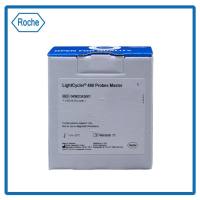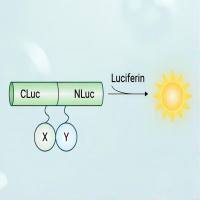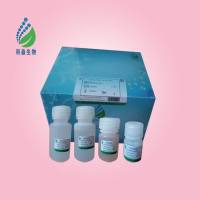Imaging of Endogenous RNA Using Genetically Encoded Probes
互联网
- Abstract
- Table of Contents
- Materials
- Figures
- Literature Cited
Abstract
Imaging of RNAs in single cells revealed their localized transcription and specific function. Such information cannot be obtained from bulk measurements. This unit contains a protocol of an imaging method capable of visualizing endogenous RNAs bound to genetically encoded fluorescent probes in single living cells. The protocol includes methods of design and construction of the probes, their characterization, and imaging a target RNA in living cells. The methods for RNA imaging are generally applicable to many kinds of RNAs and may allow for elucidating novel functions of localized RNAs and understanding their dynamics in living cells. Curr. Protoc. Chem. Biol. 3:27?37 © 2011 by John Wiley & Sons, Inc.
Keywords: RNA; imaging; GFP; fluorescence; molecular beacon
Table of Contents
- Introduction
- Strategic Planning
- Basic Protocol 1: Characterization of RNA Probes
- Basic Protocol 2: Imaging Endogenous RNA Using Genetically Engineered Fluorescent Probes
- Reagents and Solutions
- Commentary
- Literature Cited
- Figures
Materials
Basic Protocol 1: Characterization of RNA Probes
Materials
Basic Protocol 2: Imaging Endogenous RNA Using Genetically Engineered Fluorescent Probes
Materials
|
Figures
-
Figure 1. (A ) Structure of the human PUM‐HD complexed with RNA. The helical repeats are shown alternately blue and yellow, which are labeled as repeat 1(R1) to repeat 8(R8). Each repeat recognizes a specific base of RNA. (B ) Basic principle of the RNA probes. Two RNA‐binding domains of PUM are engineered to recognize specific sequences on a target mRNA (mPUM1 and mPUM2). In the presence of the target mRNA, mPUM1 and mPUM2 bind to their target sequences, bringing together the N‐ and C‐terminal fragments of EGFP, resulting in functional reconstitution of the fluorescent protein. (C ) RNA sequences of PUM‐HD for RNA. The amino acids that interact with RNA bases are shown. The amino acids in square frames are necessary for stacking between upper and lower RNA bases. The other amino acids are for hydrogen bonds or van der Waals interactions. View Image -
Figure 2. Flow chart of RNA‐probe characterization. View Image -
Figure 3. Constructs of the plasmids. FLAG, FLAG epitope; MTS, matrix‐targeting signal derived from subunit VIII of cytochrome C oxidase. The cDNA is inserted into an expression vector. View Image -
Figure 4. Fluorescence images of HeLa cells expressing GN‐mPUM1 and mPUM2‐GC stained with MitoTracker and DAPI: (A ) Localization of mitochondria, (B ) reconstituted EGFP, and (C ) mtDNA. Panels D and E show their merged images. Bar, 5 µm. The insets are enlarged images of the boxed region of (A) (bar, 1.2 µm). White arrows indicate colocalization of mtDNA and ND6 mRNA. View Image
Videos
Literature Cited
| Literature Cited | |
| Bertrand, E., Chartrand, P., Schaefer, M., Shenoy, S.M., Singer, R.H., and Long, R.M. 1998. Localization of ASH1 mRNA particles in living yeast. Mol. Cell 2:437‐445. | |
| Beverly, S.M. 2001. Enzymatic Amplification of RNA by PCR (RT‐PCR). Curr. Protoc. Mol. Biol. 56:15.5.1‐15.5.6. | |
| Bonifacino, J.S., Dell'Angelica, E.C., and Springer, T.A. 2001. Immunoprecipitation. Curr. Protoc. Mol. Biol. 48:10.16.1‐10.16.29. | |
| Buratowski, S. and Chodosh, L. A. 2001. Mobility shift DNA‐binding assay using gel electrophoresis. Curr. Protoc. Mol. Biol. 36:12.2.1‐12.2.11. | |
| Cheong, C.G. and Hall, T.M. 2006. Engineering RNA sequence specificity of Pumilio repeats. Proc. Natl. Acad. Sci. U.S.A. 103:13635‐13639. | |
| Emanuelsson, O. and von Heijne, G. 2001. Prediction of organelle targeting signals. Biochim. Biophys. Acta 1541:114‐119. | |
| Hegeman, A.D., Brown, J.S., and Lomax, M.I. 1995. Sequence of the cDNA for the heart/muscle isoform of mouse cytochrome c oxidase subunit VIII. Biochim. Biophys. Acta 1261:311‐314. | |
| Hu, C.D. and Kerppola, T.K. 2003. Simultaneous visualization of multiple protein interactions in living cells using multicolor fluorescence complementation analysis. Nat. Biotechnol. 21:539‐545. | |
| Lu, G., Dolgner, S.J., and Hall, T.M. 2009. Understanding and engineering RNA sequence specificity of PUF proteins. Curr. Opin. Struct. Biol. 19:110‐115. | |
| Miller, M.T., Higgin, J.J., and Hall, T.M. 2008. Basis of altered RNA‐binding specificity by PUF proteins revealed by crystal structures of yeast Puf4p. Nat. Struct. Mol. Biol. 15:397‐402. | |
| Nagai, T., Ibata, K., Park, E.S., Kubota, M., Mikoshiba, K., and Miyawaki, A. 2002. A variant of yellow fluorescent protein with fast and efficient maturation for cell‐biological applications. Nat. Biotechnol. 20:87‐90. | |
| Ozawa, T., Nogami, S., Sato, M., Ohya, Y., and Umezawa, Y. 2000. A fluorescent indicator for detecting protein‐protein interactions in vivo based on protein splicing. Anal. Chem. 72:5151‐5157. | |
| Ozawa, T., Sako, Y., Sato, M., Kitamura, T., and Umezawa, Y. 2003. A genetic approach to identifying mitochondrial proteins. Nat. Biotechnol. 21:287‐293. | |
| Ozawa, T., Natori, Y., Sato, M., and Umezawa, Y. 2007. Imaging dynamics of endogenous mitochondrial RNA in single living cells. Nat. Methods 4:413‐419. | |
| Tilsner, J., Linnik, O., Christensen, N.M., Bell, K., Roberts, I.M., Lacomme, C., and Oparka, K.J. 2009. Live‐cell imaging of viral RNA genomes using a Pumilio‐based reporter. Plant J. 57:758‐770. | |
| Tyagi, S. 2007. Splitting or stacking fluorescent proteins to visualize mRNA in living cells. Nat. Methods 4:391‐392. | |
| Tyagi, S. and Kramer, F.R. 1996. Molecular beacons: probes that fluoresce upon hybridization. Nat. Biotechnol. 14:303‐308. | |
| Voytas, D. 2001. Agarose gel electrophoresis. Curr. Protoc. Mol. Biol. 51:2.5A.1‐2.5A.9. | |
| Wang, X., McLachlan, J., Zamore, P.D., and Hall, T.M. 2002. Modular recognition of RNA by a human pumilio‐homology domain. Cell 110:501‐512. |









